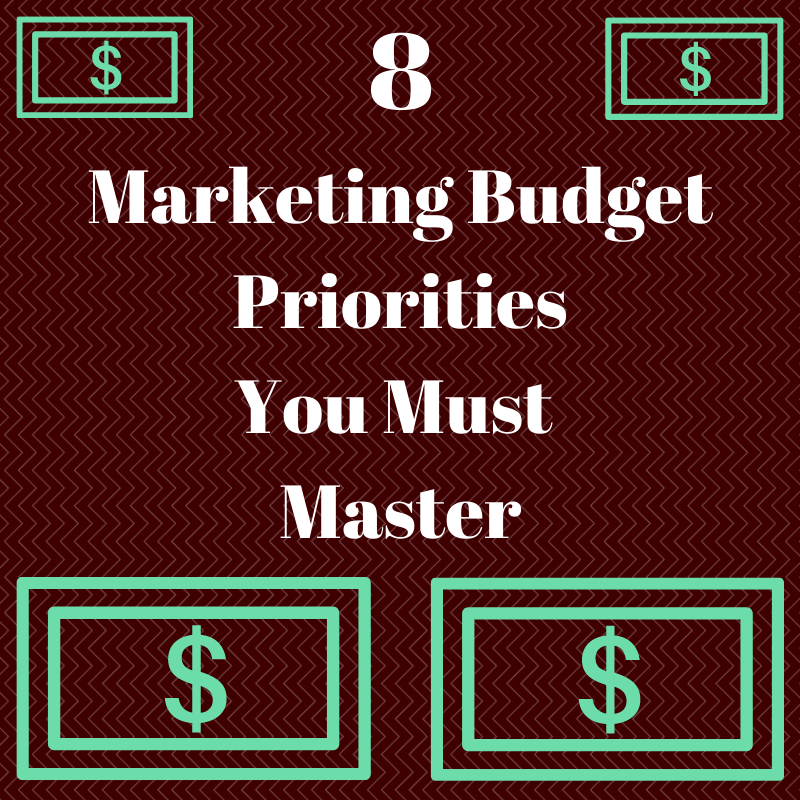The i’s have been dotted, and the t’s have been crossed on your current marketing budget. You’re wrapping up another great month of sales. You’d always like to sell more, but you’re comfortable with the direction of your store. The dollars you’ve dedicated toward your marketing are well placed and understood. As you prepare to face the gusty winds of a new month, you ask, ‘what more should I be doing to master my marketing budget?’
I’ll tell you. There are marketing strategies you need to embrace no matter what. Every one of these initiatives should be considered when preparing your marketing budget.
Preparing Your Marketing Budget Plan
1) Planning 12 Campaigns on your Calendar
Look up your historical volume of monthly units sold on each date and set realistic goals for each month’s output. Line it up with each month’s corresponding budget. Now estimate what you’d prepare to spend each month of the next 12 months. (Make sure you don’t over-allocate funds in anticipation of a presumed difficult month. It is better to underspend in those instances, and plan more low-cost guerilla-style marketing events to drive traffic during those leaner months.)
Research what monthly events/holidays you can leverage and prepare an omnichannel marketing campaign. Recognize that every single campaign you plan in advance needs, not just financial investment, but support. If you’re doing print at all one month, it should be highlighting that month’s campaign. The website should then be updated to clearly identify each month’s campaign.
As each month’s campaign changes, you should ensure all graphics and designs you develop should be used across all mediums (print, TV, video, website, email marketing, display ads, in-store signage, and more).
Now, create columns of categories under each month for:
 Print advertising
Print advertising- Direct mail
- Website / landing page creation
- Email marketing / e-blasts
- SEM / Display / Retargeting
- Off-site events
- Social media
- Optimization / Conversion tools
- Television
- Internet radio / Radio
- Additional payroll to dedicate tasks
Assign a % of budget to each category, highlighting preferred vendors (or team members), and which initiatives require a marketing budget to achieve success. Once you’ve completed this, you will know what to plan for and how to prepare for each month. As you roll out each campaign and educate your team as to the chosen “sale” for the month ahead, you’ll have the foresight to quantify spend vs. results.
2) Update your Email Templates, Text Templates, Phone Scripts, CRM Workflows, and Sales Processes
Start by putting yourself in the shoppers’ shoes. Visit your website. Submit a lead under a fake account, and mystery shop yourself. What type of online experience are you delivering? Does your website answer questions or leave you with them? Is the messaging you receive influential? Do you see that your people differentiate your store in their communication, or is it more of the same?
 To appeal to today’s mobile-focused customers, you must create simplistic, clean messaging, both online, in email, and on the phone. Processes that fire out and trigger within your CRM must be devised with both your salespeople AND shoppers in mind, rather than what management believes would be nice to see happen. When we serve our clients, this is the first thing we change as it is the easiest way to convert existing opportunities into fresh sales.
To appeal to today’s mobile-focused customers, you must create simplistic, clean messaging, both online, in email, and on the phone. Processes that fire out and trigger within your CRM must be devised with both your salespeople AND shoppers in mind, rather than what management believes would be nice to see happen. When we serve our clients, this is the first thing we change as it is the easiest way to convert existing opportunities into fresh sales.
3) Paying for the Intangible Rather than the Tangible
You can pay for leads (and you should).
You can pay for traffic (and you should).
You can pay for deep links to your VDP (and you should).
You can pay for awareness (and you should).
But in the new year, so much of your business’s future will be determined by a positive, creative saturation of your local online market. This takes personnel dedicating time, energy, and brainpower to instill goodwill in the community.
These are not things that you can simply spend money on and buy. Instead, it requires spending money on the intangible process of assembling teams in charge of finding new methods to engage shoppers and build the dealership’s brand. It may be payroll, in some instances, but you need to consider it a part of your marketing budget as well.
4) Improving Your Merchandising
Your product pictures already look great. You’re shooting in a photo studio with a high-powered camera, and you already have many photoshopped, filtered, and watermarked pictures. You can experiment with collages and memes and photoshop. It doesn’t matter, as you still need to do more. Every piece of inventory must become its own advertisement.
You can flesh out your written product descriptions, foregoing the automatically generated comments, and using data to develop customer-worthy statements regarding condition, service history, accident history, and ownership history.
 You should also build upon your product display pages (or VDPs) with digital validation to grow the value of each vehicle, with market reports, video trade testimonials, transparent pricing, price validation tools, and third-party reviews. Showing a product or piece of inventory involves lighting, high quality and quantity of pictures, video proof, well-written descriptions, and unlimited data assets to influence shoppers’ decisions.
You should also build upon your product display pages (or VDPs) with digital validation to grow the value of each vehicle, with market reports, video trade testimonials, transparent pricing, price validation tools, and third-party reviews. Showing a product or piece of inventory involves lighting, high quality and quantity of pictures, video proof, well-written descriptions, and unlimited data assets to influence shoppers’ decisions.
5) Getting Creative and Consistent with Video
This falls between the tangible and the intangible. More videos are consumed than emails are opened, and this trend will not change. Google recently released data showing that, for vehicle shoppers, the three most sought-after video content are:
- Video Test Drives
- Product Feature/Option Explanation Videos
- Walk-around/Product Demonstration Videos
 Those have been on your video agenda in the past, but you mustn’t stop there. Video throughout your website with assets such as personnel bios, customer testimonials, value propositions, how-to videos, service walk-throughs, dealership history videos, and sales process explanations.
Those have been on your video agenda in the past, but you mustn’t stop there. Video throughout your website with assets such as personnel bios, customer testimonials, value propositions, how-to videos, service walk-throughs, dealership history videos, and sales process explanations.
This takes time, planning, and a team to execute, film and edit. But it impacts your time on-site, customer engagement, and winning online shoppers over.
Don’t stop there. What videos do you like watching online? Funny videos? Videos about human-interest stories or your community? Why not bring in someone who can create unique videos to breed that theatrical type of goodwill with the viewer? Don’t stop at the necessary vehicle videos. Think cinematic and people will believe your dealership is a theater they want to attend.
6) Caring More for Your Own than for Strangers
You have a book of business stored within the databases of your technology that are worth vastly more than the contact info of a potential new client. I’ve long said great organizations recognize they need to dedicate twice the time to retaining past customers as they attempt to conquer new ones.
 Open up your CRM and develop processes, marketing, and messaging that continually build relationships between your loyal customers and the store. Something as simple as a phone call on birthdays and anniversaries should be standard. Following up via email and text every time the shopper is due for service is necessary.
Open up your CRM and develop processes, marketing, and messaging that continually build relationships between your loyal customers and the store. Something as simple as a phone call on birthdays and anniversaries should be standard. Following up via email and text every time the shopper is due for service is necessary.
Ensuring you leverage this past customer base to garner positive reviews for your business, and then promoting those reviews across social and web channels.
You can go so far as dedicating marketing budget to a “thank you department”, as I’ve detailed with some of our clients, as a means to make long-lasting impressions in an effort to build lifetime loyalty with your most worthy clients over the years. These are all priceless acts of communication that you must embrace to own a foundation of customers going forward. You must make them feel appreciated because you can only hope to earn their repeat business.
7) Enforcing Internal Training and External Sales Coaching
Consistent training and reinforcement of processes and techniques is not a one-time event. Nor should it be only performed over the course of a weekend with little reinforcement afterward. Training needs to happen internally at the hands of your own management.
We recommend daily check-ins with each salesperson, weekly save-a-deal meetings between manager and salesperson, weekly product/process group training, and monthly performance reviews with goal setting. Managers need to do just that. Manage. Ensuring the team is up to date on leveraging the in-store technology, understanding the product benefits, and following a designed process is step one to running a fluid sales organization.
 However, sales coaching should be external. When managers are in-store training, you need to ensure they aren’t just pulling ideology from their belief system but following best practices recommended by outside agencies. Sales managers have time in their day, but not enough to be an accountability task force within the CRM. Consider one of our core services:
However, sales coaching should be external. When managers are in-store training, you need to ensure they aren’t just pulling ideology from their belief system but following best practices recommended by outside agencies. Sales managers have time in their day, but not enough to be an accountability task force within the CRM. Consider one of our core services:
Virtual Dealer Training – our weekly BDC Training video calls with your team to reinforce best practices, role-play and answer questions live, or our “Teacher” Performance Management sales training and grading programs (TaskTeacher, PhoneTeacher, ShowroomTeacher) where we grade how thoroughly your team is following up with their opportunities and save you deals with consistent feedback and recaps. We gather their sales teams together in front of live, interactive video chats and address their specific needs, tailoring their ongoing education to their store.
This two-pronged approach of in-store training coupled with ongoing coaching from outside influencers allows dealer owners to trust their most valuable asset (their people) is being cared for and groomed for future success. Consider this an extension of your marketing budget as well.
8) Advertising in Social
The old sales adage of “fish where the fish are” has never been truer than today’s social media advertising. With over a billion users being targeted by, not just their area and demographics, but their interests, social media is the giant fish in the giant pond of marketing. Daily user rates continue to increase, as does mobile usage on these sites, and companies big and small are doing everything they can to grow their brand and engage valuable customers on these platforms.
However, it is not just enough to have a FB page and post to it regularly. Right now, advertising on FB is one of the best buys for the advertising dollar, and every corporation should have a line item in their marketing budget dedicated to it. Instagram is also available for businesses to explore, ad space can be purchased within different platforms, Snapchat is reaching a new generation, and every day a new app shows up that can influence a segment of the population.
Influencer marketing is taking space on social platforms so how can you leverage your own personality (or local personalities?) Organizations can no longer feel that having a presence on these sites is enough to keep them in the game. They must dedicate dollars to advertising their businesses if they hope to reach their intended consumers.
You need to prepare for what lies ahead within the industry and the economy. While the getting is good, you must batten down the hatches and determine what is influencing your business growth and what is simply spending money without influencing sales. Designing a well-thought-out game plan for a year of campaigns and ad spending shouldn’t happen quickly, nor should it take place without guidance. This detail is often missed and contributes to poor marketing budget ROI.
Nonetheless, it is a necessity for any business owner hoping, not just to stay the course, but also to thrive for the rest of the year. By following the guideline above, with enough planning, your marketing budget can be set for the entire year, and you can begin to monitor the return on your investments before the ball drops.










One Response to “8 Marketing Budget Priorities You Must Master”